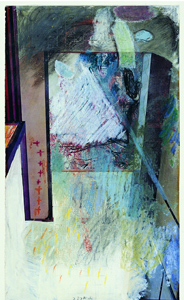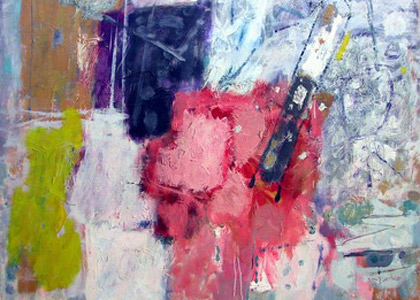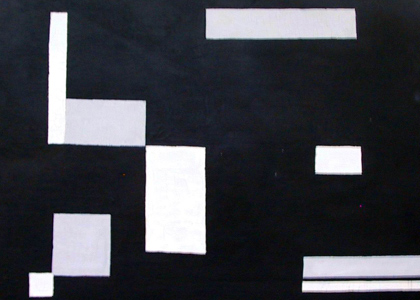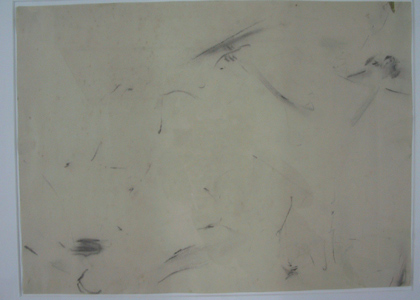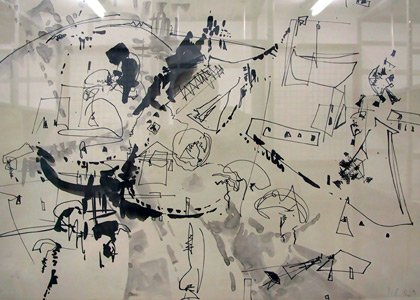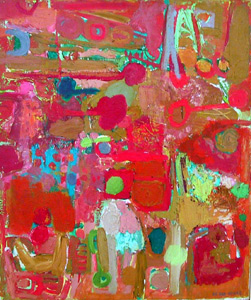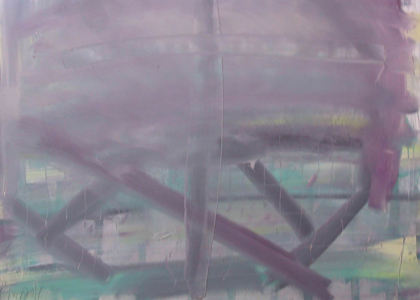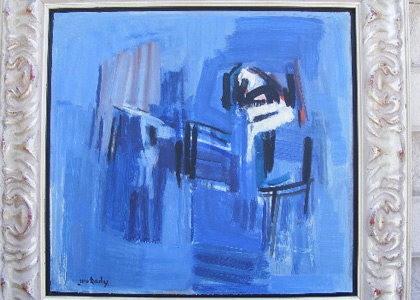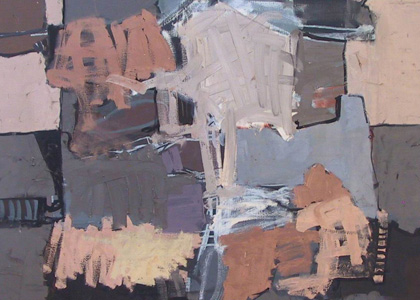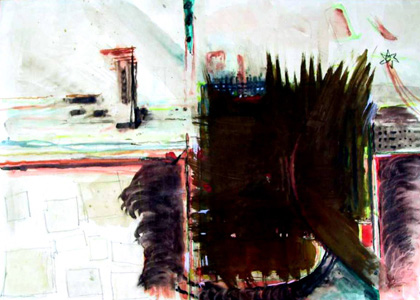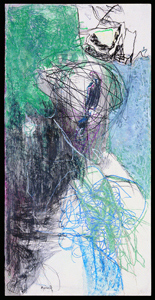Disrupted Vision
Curator: Sigal Barkai
30/10/2008 -
16/03/2009
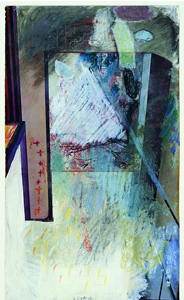
In contrast to the English adjective “abstract,” which denotes an immaterial and intangible quality, its Hebrew equivalent, mufshat (which also means “undressed,” or “denuded”), alludes to the body, to a concrete reality. Is the body hinted at in this case involuntary stripped of all covering? In contrast to the experience of a subject that undresses of his own free will, as an expression of intimacy or desire, the term “denuded” seems to denote an almost violent act of imposition upon the body of the painting, its form and matter. The Hebrew term for abstraction also alludes to an act of expansion. Indeed, the opening of the “color field” onto infinity seems to expand upon the painting’s interpretive possibilities, which stretch out to an undefined horizon line. At times, however, the encounter with the abstract canvas leads to a reaction associated with contraction, distancing, estrangement, confusion. What remains of the painting after it has been forcefully denuded? Does the process of abstraction expose the naked flesh, revealing a purer and more authentic form of existence? Or does it amount to nothing but a series of meaningless brushstrokes? Such questions concerning subject matter, legitimacy, content and meaning are as old as modernist abstraction. They arose alongside the first Cubist forms that appeared in Picasso’s works in the early 20th century, or even earlier – with the appearance of the Impressionist’s tremulous patches of color. In the 1950s, the dominant strain of Israeli art began responding to the major breakthroughs being made at the time by Western artists. This exhibition centers upon a selection of paintings from the collection of the Petach Tikva Museum of Art, which represent the process of abstraction undergone by Israeli art during this period. The compositions in question involved the abstraction, or “denuding,” of iconographic forms: identified figurative forms, forms that tell a story, forms that communicate a message, figures, landscapes, allegories containing religious, educational, moral and propaganda-related themes. Yet these seemingly defined and clearly understood forms are in fact ambiguous and open to interpretation, just like “abstract” forms. Rather than pointing to a transcendental, mystical sphere or to the crystallization of a new thematic and an original formal language, the surge of abstraction in Israeli art expressed the longing of local artists to relate to themes and forms examined by the Western avant-garde during that same period. The desire to become affiliated with an international language was especially characteristic of the members of the “New Horizons” group. This group, which was formed shortly following the foundation of the state, sought to liberate itself from politically engaged motifs associated with the Zionist movement. Indeed, many of the works included in the exhibition are simply titled “Composition.” This term, which was borrowed from the world of music, points to the desire of these artists to create an immaterial world, which hovers in a transcendental space like a series of pure, sublime musical notes. Yet could such a world truly exist in the context of visual art, whose very essence demands an encounter with the tangible elements of color, material, texture, form and support? An examination of Israeli abstraction reveals a disturbing, earthy, local presence. Could the artists who envisioned a purified artistic language indeed avoid making social or political statements? And is the lack of such statements not a statement in and of itself? Does this strain of abstraction involve a form of evasion that reveals itself by means of negation? The works included in this exhibition underscore the unique form of abstract expression to which Israeli art gave rise. In spite of, and perhaps because of the desire to distance themselves from local reality, these works involved the creation of a unique and intriguing language. This form of abstraction may certainly be defined as a local dialect, a code that is not easily deciphered by outside readers. The charged experiences surrounding the foundation of the Israeli state involved coping with emotions that cannot be contained: endless realms of pain, memory and anxiety, which could be neither circumscribed nor described. Within this hazy, multilayered and undefined painterly space, there arose emotional responses to repressed realities such as the Holocaust, war, expulsion, loss. These themes could not easily be fit into a familiar and clearly identified world of images, yet their resonance catapulted the hands of Israeli artists across the painterly support. Their visual horizon was disrupted and intentionally destabilized in order to enable random patches of color and brushstrokes to act as mediators for an ebullient mass of emotions and difficulties, which erupted from the inside out. Moshe Kupferman’s work Untitled (1972), for instance, exemplifies the eschewal of concrete definitions and commitments, and the need for a certain degree of liberating blindness. Kupferman always spoke of the need to erase; to apply paint to the canvas and then to wipe it off, and to repeat this action over and over again. Although in his everyday life Kupferman was a tireless consumer of news and current events, he isolated himself within a world that no one could fully interpret. Living in a socially engaged community, on a kibbutz (Lohamei HaGetaot) founded by Holocaust survivors, this artist chose to blind himself as a tactic of survival. This tactic enabled him to preserve his expressive and creative freedom, which could never be expropriated or limited by political wheelers and dealers and clearcut ideologies. In a context that offered a single “correct” framework through which to perceive reality, he preserved the option of multiplicity by intentionally disrupting the visible surface. Yehezkel Streichman succinctly described the tension between these two worlds in a single sentence: “I consciously confirm my Judaism and am a Zionist painter. Israeli painting must be free, tremulous and vital. […] I desire to be a good Israeli, to see how the Israeli air is reflected in my heart […] without discarding a single drop of the universal modern approach.” Like Kupferman, Streichman the Israeli citizen was highly attuned to the country’s daily reality. He described getting up every morning to the sound of the radio, and falling asleep with it at night, and posed the following rhetorical question: “We live in a unique state characterized by extreme tension and nervousness. Isn’t this reflected in painting?” This tension is indeed reflected in the Composition created by Streichman in the mid-1960s, in which a dark square competes for the viewer’s attention with the horizon, which is somewhat reminiscent of the urban structure of Tel Aviv – a “white city” crushed and concealed by a heavy, oppressive presence. Lea Nikel, by contrast, refused to consciously acknowledge reality’s impact on her paintings, and claimed to be amused by discussions of local painting and Israeli art. As an artist who searched the painterly expanse for an essential, universal and eternal quality, Nikel could not associate herself with everyday life in Israel. Nevertheless, as is evidenced by her work Composition, which is included in this exhibition, she did not deny her affinity with “memory, heat and sand dunes, or with her Hassidic or Russian origins.” Moshe Mokady similarly disavowed any affinity between his paintings and between the time and place in which they were created. The paintings included in the exhibition point to his understanding of abstraction as expressive of an existential, universal attitude centered upon the individual’s mental and emotional life. Mokedi’s adherence to this highly individualized form of art making reflected the repressed longings of many Israelis during the 1950s; a large number of them – as was later revealed – secretly mourned what they were constrained to leave behind. An intimation of loss pervades all of Mokady’s works; for this artist, painting was a refuge that provided him with a sense of belonging and intellectual liberty. This exhibition attempts to reexamine some of the familiar interpretive formulas applied to Israeli abstraction. Rather than viewing abstraction as the disavowal of subject matter in favor of a universal language of signs and visual conventions detached from a specific cultural and local context, it attempts to touch upon its complex contents and multiple meanings, which were anchored in a local reality. It seems that abstraction was simultaneously used by these artists in two different ways: as an attempt to eschew socially and politically engaged statements and to protest the dictates of the Zionist collective, and as a way of giving expression to feelings – so deep as to be impossible to contain and define – of identification with the Israeli ethos.

